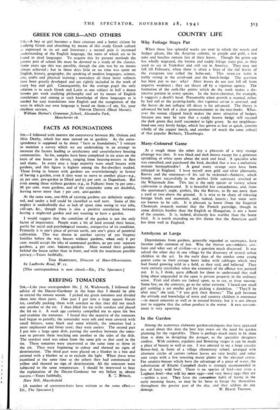When those few splendid weeks are over in which the
woods and hedges gleam, like the Assyrian cohorts, in purple and gold, a few oaks and beeches remain fast of their leaves. Though the green sap has wholly migrated, the brown and ruddy foliage stays put, as they used to say in Yorkshire and still say in America. They may not fall till February, when there is often a litter of the old leaves of the evergreen tree called the holm-oak. This reten.ive nabit is trebly strong in the scrub-oak and the beech-hedge The question has been put to me: why? Most leaves do not just fall off from negative weakness ; they are thrust off by a vigorous agency. The formation of the cork-like points which do the work makes a dis- tinctive pattern in every species. In the horse-chestnut, for example, it suggests a death's head. Presumably when growth is stunted, either by bad soil or the pruning-knife, this vigorous act:on is arrested, and the leaves do not collapse till decay is far advanced. The theory is advanced for lack of a clear pronouncement in the text-books. What- ever the reason clipped beech makes the most attractive of hedges, because you may be sure that a ruddy brown hedge will succeed the dark green that itself succeeded to light green. In my neighbour- hood one very lovely hedge, which has grown as fast as quick, consists wholly of the copper beech, and another (of much the same colour) of that popular Berberis, Thunbergia.


























 Previous page
Previous page